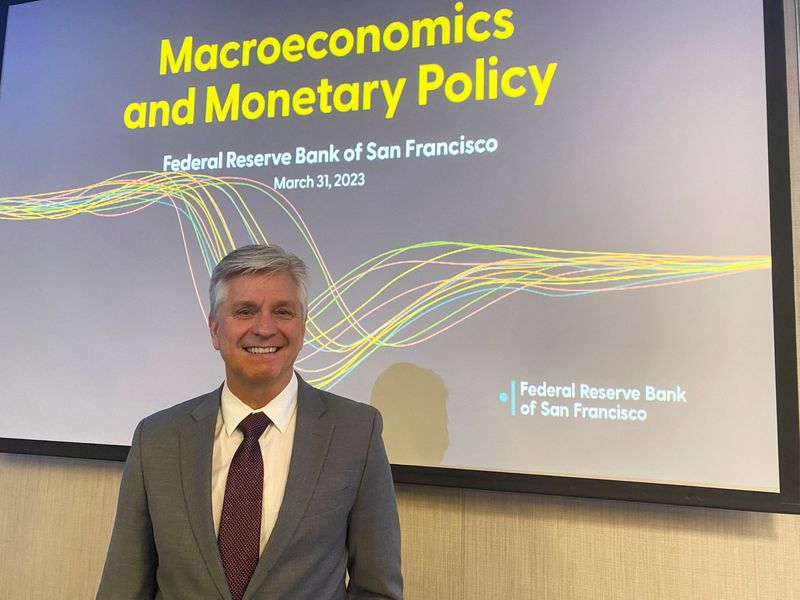By Jamie McGeever
ORLANDO, Florida (Reuters) -As the amount of cash parked at the Federal Reserve's overnight reverse repo facility (ON RRP) hurtles towards zero, the Fed's visibility on the minimum level of bank reserves needed to ensure the financial system functions smoothly also diminishes.
Once the banking system gets close to what is considered the 'lowest comfortable level of reserves' (LCLOR), the Fed is in murkier territory where credit conditions could suddenly be adversely affected, as happened in late 2019.
The daily RRP is sometimes seen as a gauge of excess reserves in the system and a barometer of how broader liquidity conditions are evolving. If it goes to zero, the Fed may be forced to tread more carefully in reducing its balance sheet.
At the current pace, the RRP balance will likely evaporate completely by the middle of the year. Many market participants and Fed officials see no problem with that, others are wary.
Two of the most influential U.S. central bankers have since addressed the issue publicly, and from slightly different angles.
Fed Governor Christopher Waller on Tuesday showed little concern about an RRP balance of zero: "There's no reason for it to have anything in it," he said at an event hosted by the Brookings Institution.
Dallas Fed President Lorie Logan, meanwhile, earlier this month said: "While the current level of ON RRP balances provides comfort that liquidity is ample in aggregate, there will be more uncertainty about aggregate liquidity conditions as ON RRP balances approach zero."
The two voices carry weight. Waller's views are generally thought to be pretty closely aligned to those of Chair Jerome Powell, while Logan was recently in charge of managing the Fed's trillions of dollars of Fed assets at the New York Fed.
BELOW $600 BLN AND FALLING
The RRP is often considered to be a proxy for overall bank reserves and liquidity in the system, and therefore a guide post for the Fed in terms of how it views the pace of reducing its balance sheet via quantitative tightening.
The RRP balance on Tuesday fell to $583 billion, the lowest since June, 2021. In June last year it exceeded $2 trillion, indicating that around $1.5 trillion of liquidity has been drained from the system in seven months.
Logan's remarks are a reminder that the Fed wants to avoid a repeat of 2019.
In September that year bank reserves dropped below the LCLOR needed to ensure the financial system plumbing functioned, repo rates shot up and the Fed was forced to halt QT and inject liquidity into the banking system.
The LCLOR is an unknowable number until it is breached and a moving target. Total bank reserves held at the Fed stand at $3.5 trillion, more than double September 2019 levels of $1.4 trillion but down from a peak of $4.3 trillion two years ago.
Deutsche Bank U.S. rates strategist Steven Zeng estimates that the RRP will continue falling briskly, by around $450 billion in the current quarter and down to zero by June.
"I don't see any need for concern - Fed officials mostly expect the RRP to go to zero. But they will have to take greater care in monitoring liquidity conditions to avoid a repeat of 2019," Zeng warns.
CAUTIOUS APPROACH
A more rapid decline might bring forward the timing of discussions around QT but not necessarily a change in policy or the pace of running down the balance sheet, at least not initially.
At the pace of contraction Zeng and others expect, it's not inconceivable that the RRP evaporates completely between Fed policy meetings. This is something officials would probably want to avoid, especially if they haven't already communicated their QT strategy to the market.
If the Fed errs on the side of caution, it may tie the pace of QT to the RRP, effectively automatically slowing the balance sheet runoff once liquidity is no longer quite so ample.
Strategists at JP Morgan, on the other hand, believe the RRP should remain large enough in order to ensure there is no money market malfunction or liquidity shock, even if the 'LCLOR' is not under threat.
"There's a growing consensus that RRP balances enable smooth functioning in money markets, thus allowing the continued effective transmission of monetary policy," they wrote last week.
This is more in line with the latest New York Fed survey of primary dealers carried out before the Fed's Dec. 12-13 policy meeting.
It shows Wall Street's titans' median forecast is for the Fed to end QT in the fourth quarter this year, with total bank reserves projected to be $3.125 trillion and the RRP balance at $375 billion.

That's down significantly from a projected $625 billion in the October survey, but still comfortably above zero. Those taking a benign stance on the RRP may have that put to the test sooner rather than later.
(The opinions expressed here are those of the author, a columnist for Reuters.)
(By Jamie McGeever; Editing by Andrea Ricci)